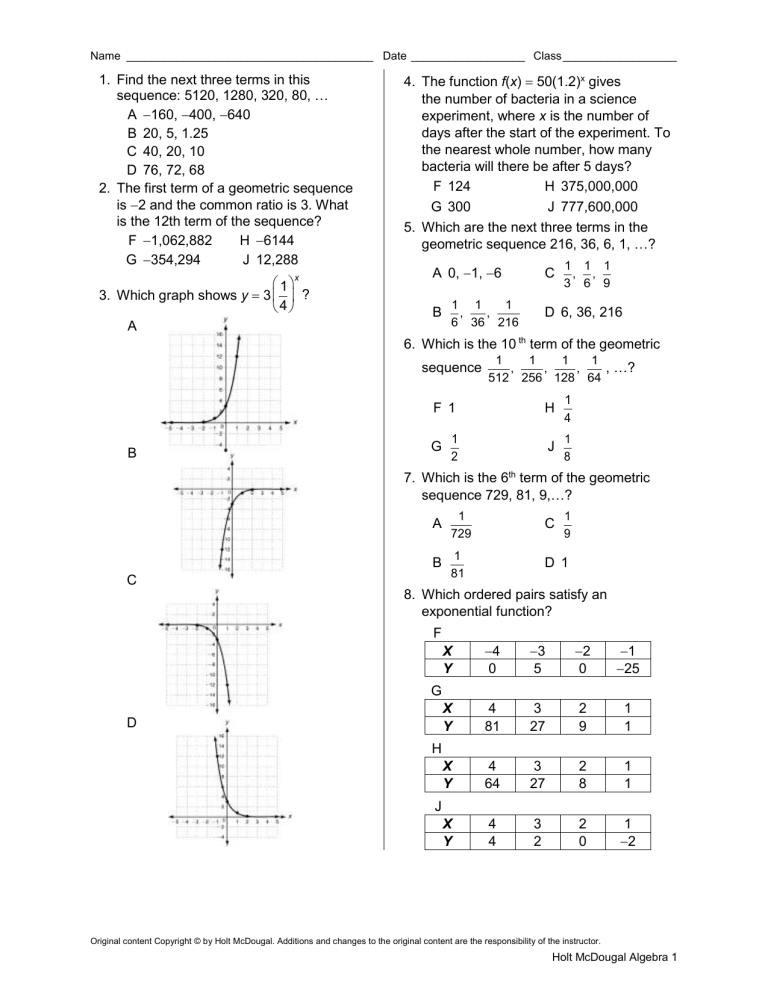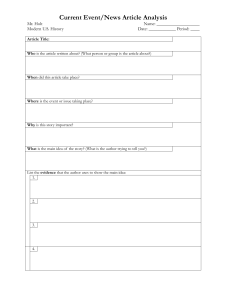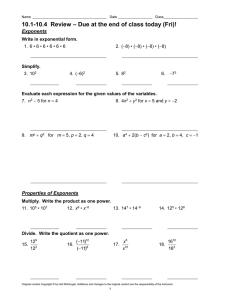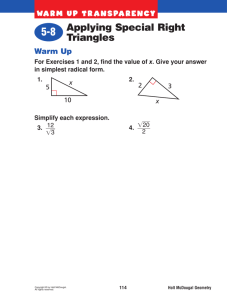
Name _______________________________________ Date __________________ Class __________________
1. Find the next three terms in this
sequence: 5120, 1280, 320, 80, …
A 160, 400, 640
B 20, 5, 1.25
C 40, 20, 10
D 76, 72, 68
2. The first term of a geometric sequence
is 2 and the common ratio is 3. What
is the 12th term of the sequence?
F 1,062,882
H 6144
G 354,294
J 12,288
1
3. Which graph shows y 3 ?
4
A
x
4. The function f(x) 50(1.2)x gives
the number of bacteria in a science
experiment, where x is the number of
days after the start of the experiment. To
the nearest whole number, how many
bacteria will there be after 5 days?
F 124
H 375,000,000
G 300
J 777,600,000
5. Which are the next three terms in the
geometric sequence 216, 36, 6, 1, …?
A 0, 1, 6
B
C
1 1
1
,
,
6 36 216
1 1 1
, ,
3 6 9
D 6, 36, 216
6. Which is the 10 th term of the geometric
sequence
B
1
1
1
1
, …?
,
,
,
512 256 128 64
F 1
H
1
4
1
2
J
1
8
G
7. Which is the 6th term of the geometric
sequence 729, 81, 9,…?
A
1
729
C
B
1
81
D 1
C
1
9
8. Which ordered pairs satisfy an
exponential function?
F
X
Y
4
0
3
5
2
0
1
25
X
Y
4
81
3
27
2
9
1
1
X
Y
4
64
3
27
2
8
1
1
X
Y
4
4
3
2
2
0
1
2
G
D
H
J
Original content Copyright © by Holt McDougal. Additions and changes to the original content are the responsibility of the instructor.
Holt McDougal Algebra 1
Name _______________________________________ Date __________________ Class __________________
9. Which set of ordered pairs satisfies an
exponential function?
A {(2, 1), (8, 2), (32, 3),
(128, 4)}
B {(1, 2), (0, 10), (1, 50), (2, 250)}
C {(1, 2), (1, 6), (1, 18), (1, 54)}
D {(1, 2), (2, 4), (3, 6), (4, 8)}
10. The number of members in a labor
union is 240, and the number increases
by 5% each year. Find the number of
members after 4 years.
F 278
H 810
G 292
J 1215
11. Iodine-131 has a half-life of
approximately 8 days. Find the
amount of iodine-131 left from a
100-gram sample after 16 days.
A 0.0015 g
C 25 g
B 0.39 g
D 32.75 g
12. Determine which kind of model best
describes this data set.
{(2, 1), (1, 2), (0, 4), (1, 8), (2, 16)}
13. Which of the following data sets is
best described by a linear model?
A {(2, 4), (1, 9), (0, 16), (1, 25)}
B {(2, 1), (1, 0), (0, 1), (1, 0)}
C {(2, 12), (1, 10), (0, 8), (1, 6)}
D {(2, 1), (1, 0), (0, 1), (1, 4)}
14. Which of the following models best
describes the data set?
{(5, 2), (6, 0), (7, 2), (8, 8)}
F linear
H exponential
G quadratic
J none
15. Martin has $200 in his savings account.
He wants to save more money. He is
looking at two investment plans. Under
plan A, he will increase his account
balance by $40 a year. Under plan B, he
will increase his account balance by 15%
each year. How much more will he save
with Plan B after 10 years?
A $209
C $26
B $92
D $2
16. Which is the average rate of change over
the interval [2, 3]?
Equation A
X
Y
0
1
1
4
2
9
3
16
Equation B
f ( x ) x 2
H A: 3, B: 1
F A: 7, B: 1
F linear
H quadratic
G exponential
J none
G A: 7, B: 1
J A: 1, B: 7
17. Which is the y-intercept of the
equations?
Equation A
X
Y
0
1
1
4
2
9
3
16
Equation B
f ( x ) x 2
A A: 1, B: 1
B A: 2, B: 0
C A: 1, B: 2
D A: 1, B: 2
Original content Copyright © by Holt McDougal. Additions and changes to the original content are the responsibility of the instructor.
Holt McDougal Algebra 1
Name _______________________________________ Date __________________ Class __________________
1. Find the next three terms in this
sequence: 224, 112, 56, 28, ...
5. Which are the next three terms in the
geometric sequence 4, 2, 1, 0.5, …?
________________________________________
________________________________________
2. The first term of a geometric sequence
is 5 and the common ratio is 2. What is
the 10th term of the sequence?
6. Which is the 10th term of the geometric
sequence 256, 128, 64, 16 , …?
________________________________________
7. Which is the 6th term of the geometric
________________________________________
3. Graph y 6(3)x.
x
sequence
1
, 1, 3,…?
3
y
________________________________________
8. Fill in the ordered pairs that satisfy the
exponential function.
X
Y
1
1
64
2
3
1
4
4
5
4
6
16
4. The function f(x) 30(1.4)x gives
the number of bacteria in a science
experiment, where x is the number of
days after the start of the experiment. To
the nearest whole number, how many
bacteria will there be after 4 days?
________________________________________
Original content Copyright © by Holt McDougal. Additions and changes to the original content are the responsibility of the instructor.
Holt McDougal Algebra 1
Name _______________________________________ Date __________________ Class __________________
9. Does this set of ordered pairs satisfy an
exponential function? Explain.
13. Which kind of model best describes
the graph?
{(2, 0.25), (1, 0.5), (0, 1.5), (1, 6)}
________________________________________
________________________________________
________________________________________
10. The number of students at a university
is 1320, and the number increases by
8% each year. Write an exponential
function to model this situation. Then
find about how many students there
will be in 5 years.
14. Which kind of model best
describes the data set?
________________________________________
11. Bismuth-212 has a half-life of 60.5
minutes. Find the amount of bismuth-212
left from a 100-gram sample after
242 minutes.
________________________________________
12. Determine which kind of model—linear,
quadratic, exponential, or square-root—
best describes this data set.
{(2, 2), (1, 1), (0, 2), (1, 7), (2, 14)}
X
1
2
3
4
Y
0.5
0.25
0
0.25
________________________________________
15. Emil has $500 in his savings account. He
wants to save more money. He is looking
at two investment plans. Under plan A, he
will increase his account balance by $150
a year. Under plan B, he will increase his
account balance by 25% each year. How
much more will he save with Plan B after
four years? Round your answer to the
nearest whole.
________________________________________
16. What is the average rate of change over
the interval [1, 1]?
Equation A
X
1
0
1
2
Y
6
4
6
12
Equation B
f ( x ) 2x 3
________________________________________
Original content Copyright © by Holt McDougal. Additions and changes to the original content are the responsibility of the instructor.
Holt McDougal Algebra 1
Name _______________________________________ Date __________________ Class __________________
Exponential Functions
Answers
10. y 1320(1.08)t; 1940
Chapter Test Form B
1. B
2. G
3. D
4. F
5. B
6. F
7. B
8. G
9. B
10. G
11. C
12. G
13. C
14. G
15. A
16. G
17. D
18. H
19. C
20. H
11. 6.25 g
12. quadratic
13. exponential
14. linear
15. $121
16. A: 0, B: 2
1. 14, 7, 3.5
2. 2560
3.
x
y
3
2
9
2
2
3
1 2
0
6
1
18
2
54
3
162
4. 115
5. 0.25, 0.125, 0.0625
6.
1
4
7. 81
8.
1
,1
16
9. no; as the x-values increase by a
constant amount, the y-values are
not multiplied by a constant amount.
Original content Copyright © by Holt McDougal. Additions and changes to the original content are the responsibility of the instructor.
Holt McDougal Algebra 1



